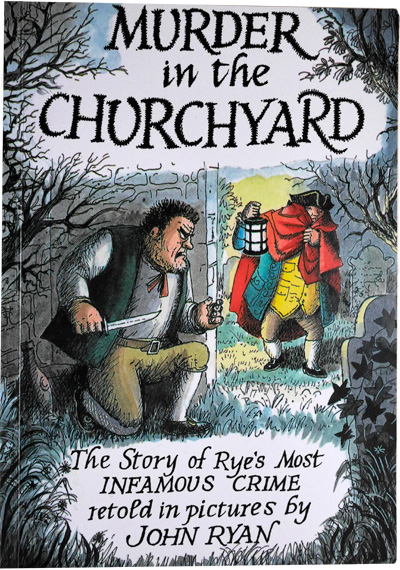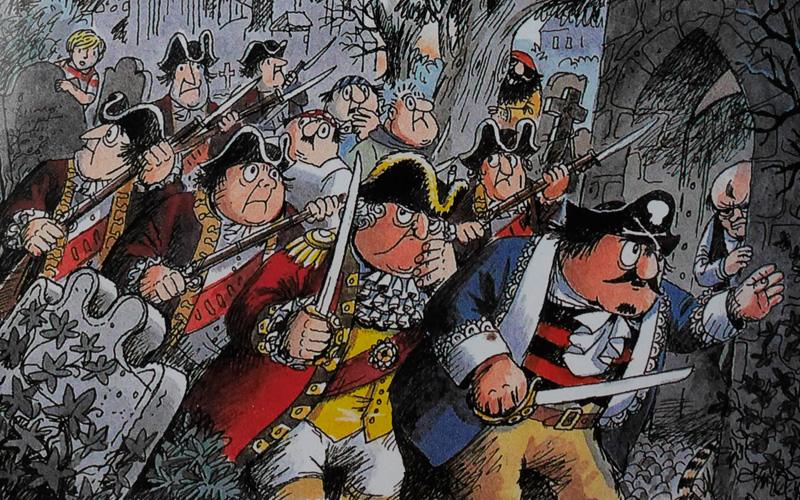The recent filming flurry in Rye may have inspired the grown-ups to read (or reread) the Mapp and Lucia books and visit (or revisit) Lamb House, home of Henry James and E. F. Benson, but are the town’s youngsters aware of the really good stories for them which take place in Rye? Any of the following would make sure-to-please Christmas presents. They are listed in ascending order of reader age.
A Kindle of Kittens
By Rumer Godden
Pan MacMillan Children’s Books 1978

As She-Cat, a stray garbage-eating tabby, goes about Rye finding suitable homes for her kindle of kittens, she and the reader become acquainted with the streets, roofs, cats and people of the town. The Town Hall and Town Crier, the Mermaid Inn, Lamb House, the corner of Market and Pump Streets, a poet in jeans, old ladies — and rude boys — are endearingly shown both in the words and in the illustrations by Lynne Byrnes.
The Tale of the Faithful Dove
By Beatrix Potter
Warne 1956
In Folkestone Beatrix Potter heard a story about a dove trapped down a chimney and her faithful mate, but for her own story she brought the pair — Mr Tidler and Arabella –to Rye, our “little old red-roofed town”, where they nested in the Ypres Tower and where Arabella escapes from a falcon by tumbling down an abandoned chimney on Mermaid Street. We know the house as Robin Hill, one-time home of Miss Potter’s friend the illustrator Mabel Lucie Attwell. Some editions of the book show Robin Hill on the cover. Besides the heroic Mr Tidler with his endless deliveries of life-saving corn, the story features the Town Hall, town pump, dancing mice dressed in lace, memories of smuggling days, helpful starlings and a happy-ending rescue of Arabella – and baby Toby, too.
Captain Pugwash and the Huge Reward: a tale of smuggling in the ancient town of Sinkport
By John Ryan
Rye: Gungarden Books, 1991
Those who know Rye (Sinkport) will recognise its streets and buildings in the charming illustrations, though they have acquired wonderfully inventive new names: Barmaid Street, Mutton House, Witchball Street, Baddie’s Tower, the Sand Gate, Soap Walk, Least Street, the Gingarden, the Jolly Jailer . . . A sheer delight for all ages.
Murder in the Churchyard: the story of Rye’s most infamous crime retold in pictures
By John Ryan
Rye: Gungarden Books, 1997

The creator of the Captain Pugwash books and films records his own version in words and his inimitable drawings of how it came about that John Breeds, “sanguinary butcher” murdered Alan Grebell in the Rye churchyard on a dark night, thinking he was Mayor James Lamb. The author lived at Rye’s Gungarden across from the church and used to walk his dog each night around the scene of the murder.
The Town that Went South
By Clive King
London: Hamish Hamilton, 1959. Also Puffin Books
While teaching in Rye, Clive King produced two of his best-loved books, the second being his most famous: the children’s classic and TV favourite Stig of the Dump (boy discovers a Stone Age cave-dweller in a disused Kent chalk pit). The earlier The Town That Went South is set in Ramsly (Rye), whose people wake one day to find that their town has come adrift and is floating gently across to France – Town Hall, gasworks, Gargoyle the cat, the ladies of Church Square, children of Ropewalk Street, vicar and all. It continues to float south, to Africa and the South Seas, Australia and on, Ramslyers disappearing along the way, except for Gargoyle, who becomes the first cat to reach the South Pole.
The Bells of Rye
By Richard Church
London: Heinemann, 1960

This exciting and colourful adventure story is set in Rye in the 1370s, when the French attacked and burned Rye and carried off its church bells and the men (and some boys) of Rye and Winchelsea reciprocated in the following year. John Finch, the boy hero, lives on Watchbell Street. He and a sharp-witted hunchback foil a traitor’s ambush by stowing away on one of the avenging ships. Actual events and characters of the time form the background of the story: a good introduction for youngsters to a key episode in the town’s history.
More next time . . .
Jean Floyd is a director of the Rye Museum



